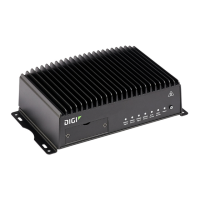Diagnostics and troubleshooting Analyze traffic
Digi TransPort WR Routers User Guide
267
Log level Conditions indicated
Informational Normal operational messages that require no action.
Debugging
Useful information for Digi Technical Support and Engineering to use in debugging
the device.
The default level at which events are logged is info, which means that any event of a level info or
higher is logged. To change the event logging level, see Configure options for event and system logs.
Analyze traffic
The traffic analyzer captures data traffic on any of the WAN and LAN interfaces and decodes the
captured data traffic for diagnosis.
You can capture data traffic on multiple interfaces at the same time, and define capture filters to
reduce the amount of data traffic captured.
You can capture up to 10MBof data traffic, in two 5 MB files.
To perform more detailed analysis, you can upload the captured data traffic from the device and view
it using a third-party application, such as Wireshark (www.wireshark.org).
WARNING! Enabling data traffic capture significantly affects device performance.
Capture data traffic
You can capture up to 10MBof data traffic, in 2 files of up to 5 MB each.
WARNING! Enabling data traffic capture significantly affects device performance.
To capture data traffic, use the analyzer command.
The analyzer command has the following parameters:
state
Enables or disables the capturing of data traffic. As this configuration can be saved, it means that
the device can be configured to start capturing data as soon as it boots up.
interfaces
Defines the interfaces on which data is captured.
filter
Defines the capture filter to reduce the amount of data traffic being captured. The filters use the
BPF syntax for defining filters, described at http://www.tcpdump.org/manpages/pcap-filter.7.html.
See Example filters for capturing data traffic for examples of using the syntax to define filters.
Note Captured data traffic is captured into RAM and is lost when the device reboots, unless you save
the traffic to a file. See Save captured data traffic to a file.

